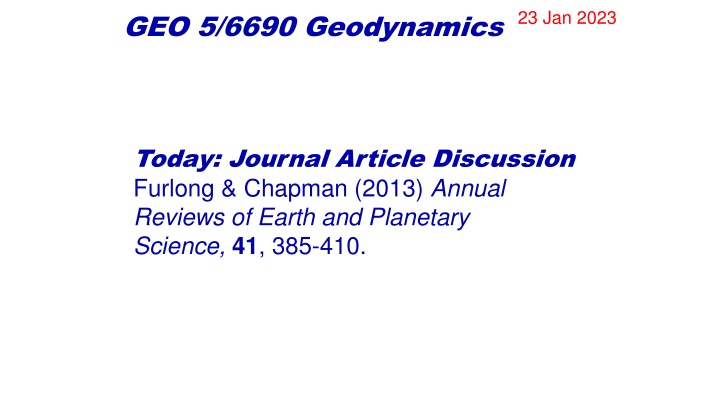
Insights into Global Heat Flux Distribution and Geothermal Processes
Explore recent research on global heat flux distribution, with insights into the Earth's geodynamics, mantle radioactivity, and surface heat flow relationships. Discover the complexities of heat production from oceans, continents, and the lower mantle, shedding light on the variability of basal heat contributions and geothermal processes affecting lithospheric cooling.
Download Presentation

Please find below an Image/Link to download the presentation.
The content on the website is provided AS IS for your information and personal use only. It may not be sold, licensed, or shared on other websites without obtaining consent from the author. If you encounter any issues during the download, it is possible that the publisher has removed the file from their server.
You are allowed to download the files provided on this website for personal or commercial use, subject to the condition that they are used lawfully. All files are the property of their respective owners.
The content on the website is provided AS IS for your information and personal use only. It may not be sold, licensed, or shared on other websites without obtaining consent from the author.
E N D
Presentation Transcript
GEO 5/6690 Geodynamics 23 Jan 2023 Today: Journal Article Discussion Furlong & Chapman (2013) Annual Reviews of Earth and Planetary Science, 41, 385-410.
Recent estimates: total global heat flux is 4647 TW (92 mW/m2) ~32 TW from oceans (105 mW/m2) ~15 TW continents (71 mW/m2) ~8 TW ~10 TW ~7 8 TW ~20 25 TW Attributes 10 TW to lower mantle radioactive heating (based on?); 5 15 TW to Core; remainder to continental heat production and mantle secular cooling
Suggest depth distribution of A might best be approximated as constant within layers... Systematic difference between xenoliths and exposed lower crustal rocks?
Observations of a linear relationship of surface heat flow to surface heat production can be fit by many different possible models Exponential decrease, linear decrease, or even just random!
Note this assumes a constant ratio of radioactive to total heat flow! A= 0.4qs A= 0.26qs Differences in these two sets of geotherms are how much of total heat flow is from crustal heat production Melting depends on temperature, pressure & hydration state
This instead allows for a variable ratio of basal (or crustal) contribution to total heat flux Metamorphism Grey is range of metamorphic grade found in rocks Blue is steady-state conditions in stable continental lithosphere
Time-dependence of surface heat flow following lithospheric strain events
Both exhumation and cooling increase surface heat flow and contribute to curvature of the geotherm, so must be corrected for in thermochronology
